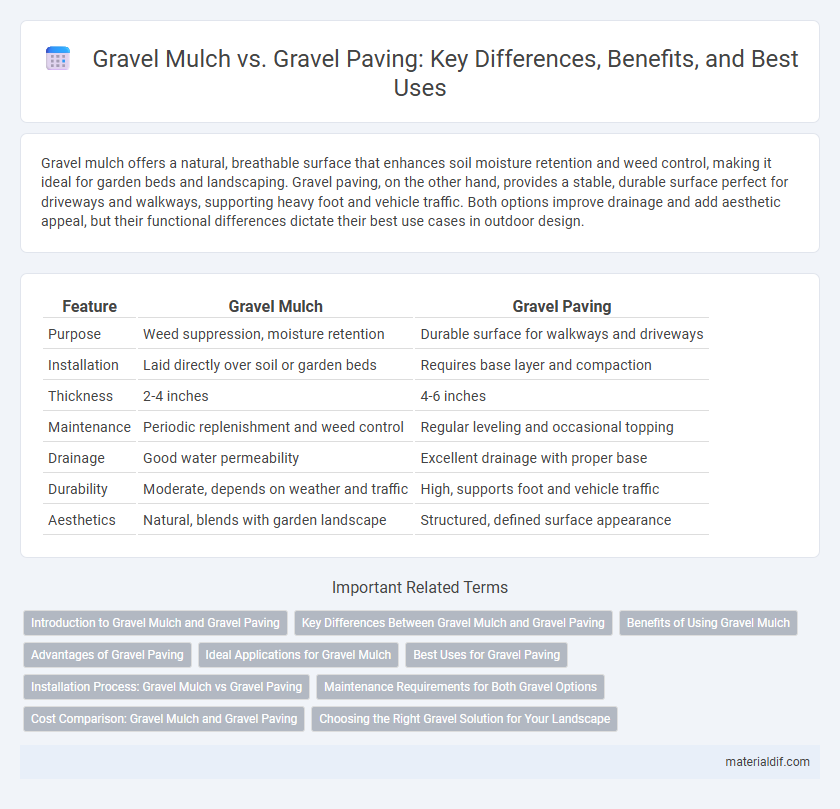Gravel mulch offers a natural, breathable surface that enhances soil moisture retention and weed control, making it ideal for garden beds and landscaping. Gravel paving, on the other hand, provides a stable, durable surface perfect for driveways and walkways, supporting heavy foot and vehicle traffic. Both options improve drainage and add aesthetic appeal, but their functional differences dictate their best use cases in outdoor design.
Table of Comparison
| Feature | Gravel Mulch | Gravel Paving |
|---|---|---|
| Purpose | Weed suppression, moisture retention | Durable surface for walkways and driveways |
| Installation | Laid directly over soil or garden beds | Requires base layer and compaction |
| Thickness | 2-4 inches | 4-6 inches |
| Maintenance | Periodic replenishment and weed control | Regular leveling and occasional topping |
| Drainage | Good water permeability | Excellent drainage with proper base |
| Durability | Moderate, depends on weather and traffic | High, supports foot and vehicle traffic |
| Aesthetics | Natural, blends with garden landscape | Structured, defined surface appearance |
Introduction to Gravel Mulch and Gravel Paving
Gravel mulch consists of loose stones spread over soil to improve drainage, reduce weed growth, and enhance soil moisture retention, making it ideal for garden beds and landscaping. Gravel paving involves embedding gravel into a stable base such as compacted sand or resin to create solid, durable surfaces suitable for driveways, pathways, and patios. Both methods utilize aggregates like pea gravel or crushed stone but serve distinct functional and aesthetic purposes in outdoor design.
Key Differences Between Gravel Mulch and Gravel Paving
Gravel mulch primarily serves as a decorative ground cover that aids in moisture retention and weed suppression, while gravel paving is engineered for durability and load-bearing to create stable walkways or driveways. Gravel paving incorporates a compacted base layer and edging to prevent shifting, contrasting with gravel mulch's loose application over soil or landscaping fabric. The key difference lies in function and installation, with gravel paving designed for structural support and gravel mulch focused on aesthetics and garden health.
Benefits of Using Gravel Mulch
Gravel mulch improves soil moisture retention and reduces weed growth, creating a healthier environment for plants compared to gravel paving. It enhances soil temperature regulation and prevents erosion, which supports sustainable landscaping. Gravel mulch also allows better water infiltration, benefiting plant root systems more effectively than hard, impervious gravel paving surfaces.
Advantages of Gravel Paving
Gravel paving offers superior durability and stability compared to gravel mulch, making it ideal for driveways and walkways that require long-lasting, load-bearing surfaces. The interlocking nature of gravel paving materials improves compaction and reduces erosion, enhancing overall landscape resilience. This method also provides better drainage while maintaining a clean, polished appearance suitable for both residential and commercial applications.
Ideal Applications for Gravel Mulch
Gravel mulch is ideal for garden beds, landscaping around plants, and pathways where water drainage and weed suppression are priorities. It enhances soil moisture retention and prevents erosion while creating a natural aesthetic that blends seamlessly with surrounding vegetation. Gravel mulch is best suited for areas that require occasional foot traffic rather than heavy loads or vehicle use.
Best Uses for Gravel Paving
Gravel paving is best suited for driveways, pathways, and patios due to its durability and permeability, allowing water to drain efficiently and reducing runoff. Its compacted surface provides a stable, low-maintenance solution that supports vehicle and foot traffic while maintaining an attractive, natural appearance. Compared to gravel mulch, gravel paving offers enhanced load-bearing capacity and longevity, making it ideal for high-traffic outdoor areas.
Installation Process: Gravel Mulch vs Gravel Paving
Gravel mulch installation involves spreading a layer of gravel directly over soil or landscape fabric, providing a simple and cost-effective method for weed control and moisture retention. Gravel paving requires a more complex process, including excavation, laying a compacted base of crushed stone, and installing edging to ensure stability and longevity. The gravel paving installation offers a durable, load-bearing surface suitable for driveways and walkways, whereas gravel mulch serves primarily decorative and protective purposes in garden beds.
Maintenance Requirements for Both Gravel Options
Gravel mulch requires periodic raking and replenishing to maintain an even surface and prevent weed growth, while gravel paving demands less frequent upkeep due to its stabilized base and integrated edging. Both options benefit from occasional weed control treatments and debris removal, but gravel paving generally offers superior longevity with minimal maintenance. Proper drainage and regular inspection are essential to avoid displacement and ensure the durability of either gravel installation.
Cost Comparison: Gravel Mulch and Gravel Paving
Gravel mulch typically costs between $1 to $3 per square foot, making it a budget-friendly option for landscaping that improves soil moisture retention and suppresses weeds. Gravel paving, on the other hand, ranges from $3 to $7 per square foot due to additional materials like sand bases and labor-intensive installation processes required for durability and stability. Considering long-term maintenance, gravel paving often incurs higher upfront costs but offers greater longevity compared to gravel mulch, which may need replenishing more frequently.
Choosing the Right Gravel Solution for Your Landscape
Gravel mulch enhances soil moisture retention and weed control, making it ideal for garden beds and around plants, while gravel paving provides a durable, permeable surface suitable for driveways and walkways. Selecting the right gravel solution depends on your landscape's functional needs, aesthetic preferences, and maintenance requirements, with factors like drainage, load-bearing capacity, and particle size playing crucial roles. Understanding these distinctions ensures a sustainable and visually appealing gravel application tailored to your outdoor space.
Gravel Mulch vs Gravel Paving Infographic

 materialdif.com
materialdif.com